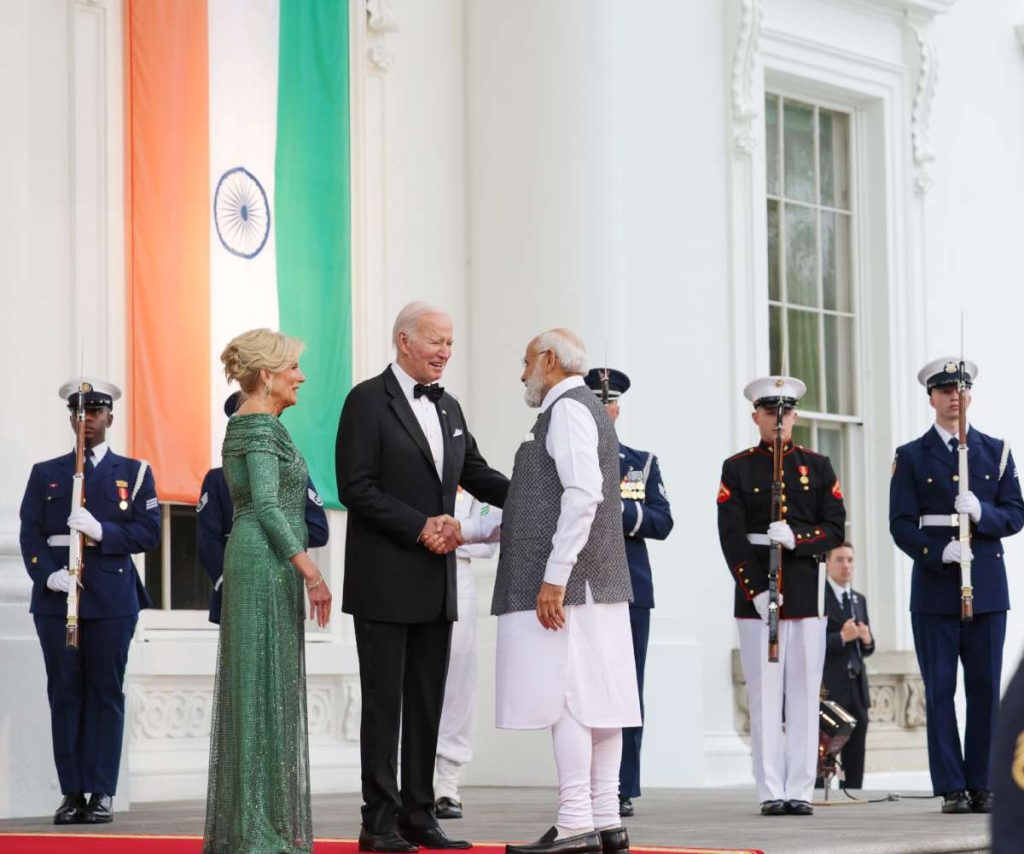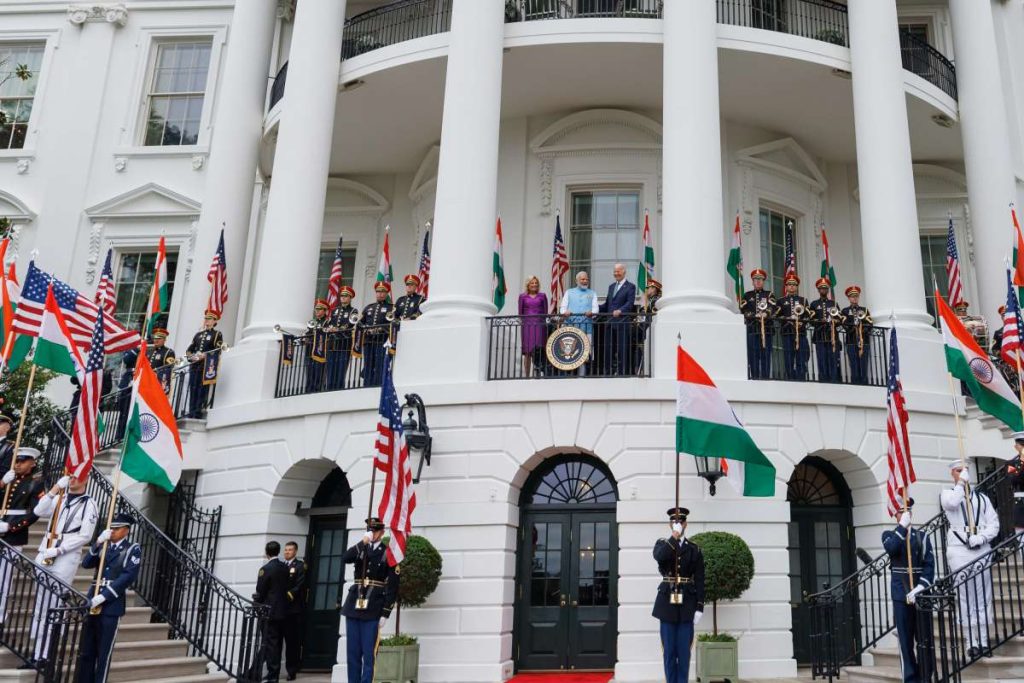
The main agenda of Prime Minister Modi’s visit to the USA is stepping up defence cooperation between India and the U.S., setting a roadmap for industries in the defence sector to partner closely in co-production, co-development and maintaining supply chains … writes Kaliph Anaz
Prime Minister Narendra Modi’s current visit to the USA is poised to set new benchmarks in bilateral ties between the biggest democracy and the oldest democracy in the world, alarm bells have started ringing in autocratic China.
The main agenda of the visit is stepping up defence cooperation between India and the U.S., setting a roadmap for industries in the defence sector to partner closely in co-production, co-development and maintaining supply chains, Indian Foreign Secretary Vinay Mohan Kwatra has been quoted as saying.
Fearing the prospect that the tables will now be turned against China along the India– China border across the great Himalayan range, President of China Xi Jinping has called upon border troops of China to forge a “great wall of steel” across the country’s frontiers by enhancing their capabilities in border defence and control.
From the offensive rhetoric of “teaching India a lesson again after 1962,” the tone has suddenly turned defensive. Deep down, the Communist Party of China has the feeling that its border with India along occupied Tibet is no longer that impregnable.

Though President Xi has made the statement following a visit to Inner Mongolia, his apprehensions have been about the situation on the China – India border. Foreign Minister of India S. Jaishankar has lately made it clear that till Chinese troops vacate all the disputed territories in eastern Ladakh there cannot be any improvement in India– China relations.
The statement of President Xi has also betrayed his apprehensions about the weakness and shortcomings of the People’s Liberation Army and the state of his government. He has highlighted the need for more cooperation in border defence among the ruling Communist Party of China and different departments of his government, the military, the law enforcement agencies and the ordinary people. He has also stressed on the need for more intensified training of troops, to enhance combat preparedness and meet the shortcomings in information technology-related border defence and control. President Xi has also spoken on the need for tightening military discipline, maintaining good troops on the border and strengthening the ranks of border defence professionals.
He has asked Chinese troops to have a stronger sense of mission and responsibility and the army to guard the border diligently, There is need for more cohesion among the border troops of China, President Xi has said. Clearly, with the PLA of China facing all these shortcomings, it will not be easy to build the great wall of steel.
The Pentagon indicated on June 9, 2023, the visit by the Indian Prime Minister to the USA would be marked by big announcements on defence industrial cooperation and boosting the indigenous military base of India.
“Among the priorities are clear strategic alignment around the question of co-development and co-production between the United States and India on the defence side. This is a priority for Prime Minister Modi to strengthen India’s indigenous defence industrial base, as well as advancing the military modernisation,” U.S. Assistant Secretary of Defense for Indo-Pacific Security Affairs Ely Ratner has been quoted as saying in news agency reports from Washington.
“One of the major thrusts of the bilateral defence relationship and one of the things we were talking about, while we were in Delhi, is this ongoing US effort to support India’s military modernisation. The integration of our defence industrial base is more co-production, co-development, and I think that is based upon the belief that a stronger India that can defend its own interest and its sovereignty is good for the United States,” he said.
The initiative was believed to have been launched when National Security Advisor of India Ajit Doval met the U.S. National Security Advisor Jake Sullivan in January 2023 and launched the initiative for bolstering technology cooperation between the U.S. and India in the area of critical and emerging technology; with a strong defence component in it. Early in June 2023 U.S. Secretary of Defence Lloyd Austin visited India to lay the groundwork for the visit of Narendra Modi and finalize particular agreements and initiatives.

One of the positive outcomes of the Indo – U.S. cooperation in the area of defence is immediately visible, the decision of New Delhi to acquire hi-tech drones from the United States. The Indian Defence Ministry has given approval for the acquisition of 31 armed MQ-9B Reaper drones. The high-altitude long-endurance drones are armed with strike missiles which can hit enemy targets with pinpoint accuracy. The drones will also be used for long-range surveillance along the borders and maritime areas of India.
The acquisition of these drones by India has come as bad news for China because all these years China had been surreptitiously nibbling into Indian territories along the international borders, taking advantage of the peaceful intentions of India. Beginning with 1958 when China built its Western Highway through Indian territories in Aksai Chin unnoticed, Beijing has adopted this tactic numerous times against India. In 1986, the Sumdorong Chu valley in Arunachal Pradesh was occupied by the Chinese army when unsuspecting Indian security forces had retreated temporarily from an observation post during the harsh winter. Then again in 2020, the Chinese army gained control of large parts of the disputed territories in eastern Ladakh; taking the chance of the unsettling conditions during the Covid-19 pandemic.
New Delhi has thus realized that Beijing is not to be trusted at any cost, and a hawk’s eye must be maintained to save Indian territories from predatory Chinese actions. These drones will help to maintain vigil on the border and take note of movements of the Chinese army and their intentions. The sophisticated weapon system on board the drones will also help the Indian army take preventive actions against aggressive Chinese moves.
In fact, unarmed versions of the deadly Predator series, MQ9 Guardian/Predator B, have already been leased from the USA as emergency procurement in the backdrop of the tension with China in Ladakh. These are also in service with the Indian Navy to maintain vigil in the Indian Ocean region.
Another focus area of importance in the field of cooperation between the American and the Indian militaries is the sharing of information. The importance of this exercise was demonstrated in the practical field on December 9, 2022, when the Indian army foiled an attempt by the Chinese army at land grab at Yangtse in the Tawang sector in Arunachal Pradesh; the way the Chinese did it in eastern Ladakh in April 2020.
According to reports from the U.S., India could repeal the Chinese military incursion in time because of unprecedented information sharing with the U.S. military. Indian troops were awaiting the arrival of Chinese troops into Indian territories. Aided by the advance information, they were fully prepared.
The information shared by the Pentagon included actionable satellite imagery and was more detailed and delivered more quickly than anything the U.S. had shared previously with the Indian military. The intelligence sharing arrangement was the result of an agreement signed between Washington and New Delhi in 2020 known as the Basic Exchange and Cooperation Agreement on Geospatial Cooperation.
This had apparently caught the Chinese army off-guard and forced the Communist Party of China to reconsider its strategy at land grabs along the border. Beijing, according to reports, was enraged; but no one has paid attention to the impotent rage.
Besides putting a stop to Chinese aggression along the India – China boundary, the other focus area of the defence cooperation between India and the USA is to protect the Indian Ocean region from aggressive Chinese designs, says the Pentagon. “We are also enhancing operational coordination in a number of different places. A lot of focus is on the Indian Ocean, a lot of focus on the undersea domain, as well as new domains, space and cyber and new efforts around information sharing,” the U.S. Assistant Secretary for Defense has been quoted as saying. “The USA and India share a vision for a free and open Indo-Pacific. A strong U.S.-India partnership is a critical ingredient to realizing this vision. Both sides have understood that a closer partnership is going to be essential to the manifestation of this vision.”
Besides the USA and India, several other world powers have been feeling the need to ensure a free, open and thriving Indo-Pacific in the backdrop of enhanced military manoeuvres of China in the region. Denying the claims of Taiwan, the Philippines, Brunei, Malaysia and Vietnam, China is trying to establish its hegemony on the entire South China Sea; setting up artificial islands and military installations in the region.


